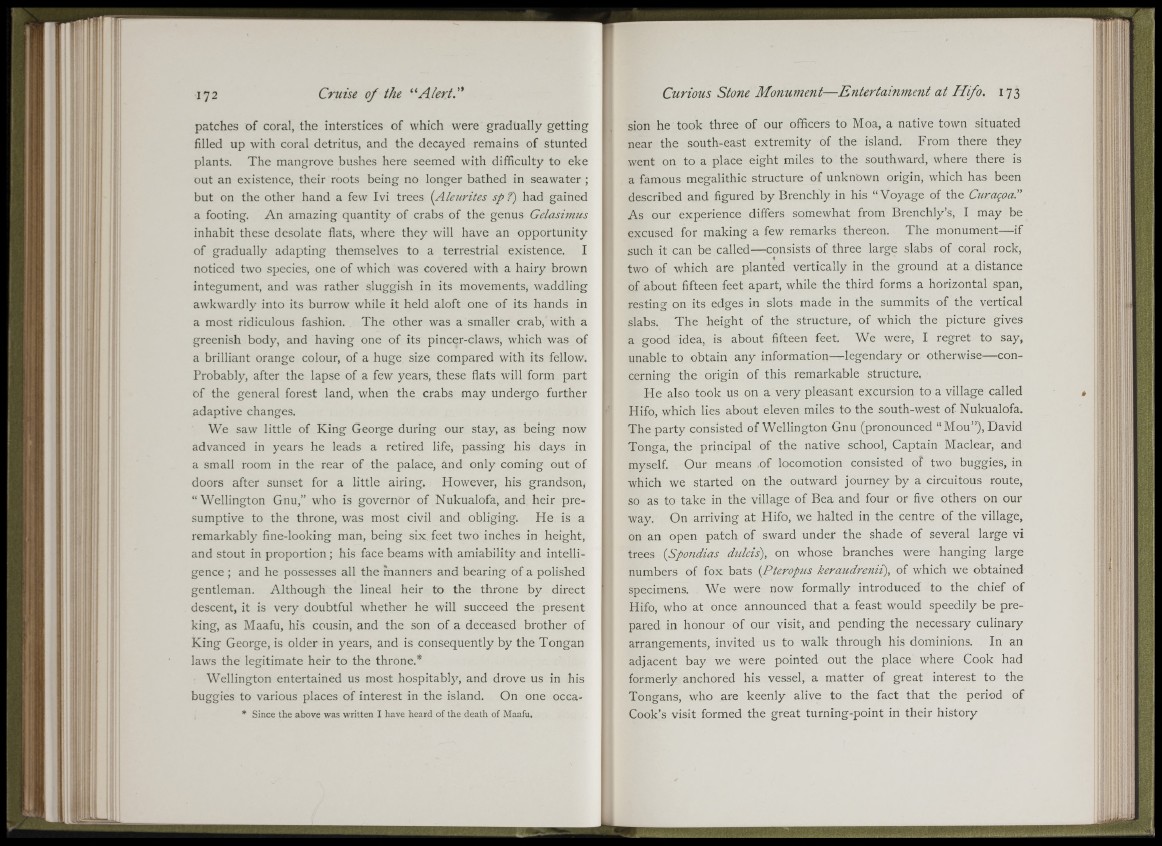
li!
iL. .
ii', r:
patches of coral, the interstices of which were gradually getting
filled up with coral detritus, and the decayed remains of stunted
plants. The mangrove bushes here seemed with difficulty to eke
out an existence, their roots being no longer bathed in seawater ;
but on the other hand a few Ivi trees {Aleurites sp?) had gained
a footing. An amazing quantity of crabs of the genus Gelasimus
inhabit these desolate flats, where they will have an opportunity
of gradually adapting themselves to a terrestrial existence. I
noticed two species, one of which was covered with a hairy brown
integument, and was rather sluggish in its movements, waddling
awkwardly into its burrow while it held aloft one of its hands in
a most ridiculous fashion. The other was a smaller crab,'with a
greenish body, and having one of its pincer-claws, which was of
a brilliant orange colour, of a huge size compared with its fellow.
Probably, after the lapse of a few years, these flats will form part
of the general forest land, when the crabs may undergo further
adaptive changes.
We saw little of King George during our stay, as being now
advanced in years he leads a retired life, passing his days in
a small room in the rear of the palace, and only coming out of
doors after sunset for a little airing. However, his grandson,
“ Wellington Gnu,” who is governor of Nukualofa, and heir presumptive
to the throne, was most civil and obliging. He is a
remarkably fine-looking man, being six feet two inches in height,
and stout in proportion; his face beams with amiability and intelligence
; and he possesses all the manners and bearing of a polished
gentleman. Although the lineal heir to the throne by direct
descent, it is very doubtful whether he will succeed the present
king, as Maafu, his cousin, and the son of a deceased brother of
King George, is older in years, and is consequently by the Tongan
laws the legitimate heir to the throne.*
Wellington entertained us most hospitably, and drove us in his
buggies to various places of interest in the island. On one occa-
* Since the above was written I have heard of the death of Maafu.
Curious Stone Monument— Entertainment at H fo . 173
sion he took three of our officers to Moa, a native town situated
near the south-east extremity of the island. From there they
went on to a place eight miles to the southward, where there is
a famous megalithic structure of unknown origin, which has been
described and figured by Brenchly in his “Voyage of the Curai^oar
As our experience differs somewhat from Brenchly’s, I may be
excused for making a few remarks thereon. The monument— if
such it can be called— consists of three large slabs of coral rock,
two of which are planted vertically in the ground at a distance
of about fifteen feet apart, while the third forms a horizontal span,
resting on its edges in slots made in the summits of the vertical
slabs. The height of the structure, of which the picture gives
a good idea, is about fifteen feet. We were, I regret to say,
unable to obtain any information— legendary or otherwise— concerning
the origin of this remarkable structure.
He also took us on a very pleasant excursion to a village called
Hifo, which lies about eleven miles to the south-west of Nukualofa.
The party consisted of Wellington Gnu (pronounced “Mou”), David
Tonga, the principal of the native school. Captain Maclear, and
myself. Our means of locomotion consisted of two buggies, in
which we started on the outward journey by a circuitous route,
so as to take in the village of Bea and four or five others on our
way. On arriving at Hifo, we halted in the centre of the village,
on an open patch of sward under the shade of several large vi
trees {Spondias dulcis), on whose branches were hanging large
numbers of fox bats {Pteropus keraudrenii), of which we obtained
specimens. We were now formally introduced to the chief of
Hifo, who at once announced that a feast would speedily be prepared
in honour of our visit, and pending the necessary culinary
arrangements, invited us to walk through his dominions. In an
adjacent bay we were pointed out the place where Cook had
formerly anchored his vessel, a matter of great interest to the
Tongans, who are keenly alive to the fact that the period of
Cook’s visit formed the great turning-point in their history
fiii